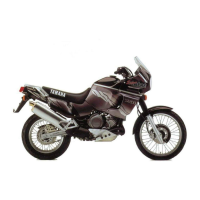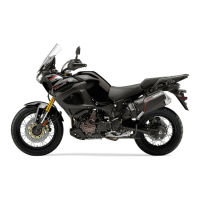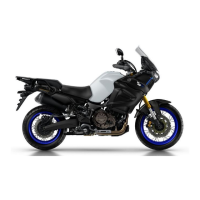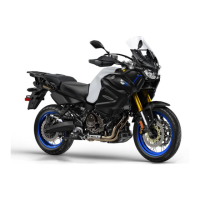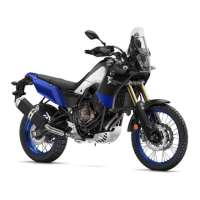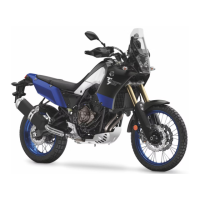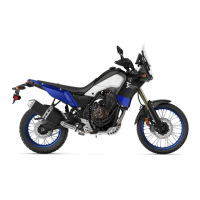Do you have a question about the Yamaha TENERE XT660Z and is the answer not in the manual?
Emphasizes owner's responsibility for safe operation, riding techniques, and accident prevention.
Details essential protective apparel and warnings about carbon monoxide poisoning from exhaust.
Covers safe loading, accessory choices, modifications, and motorcycle transport guidelines.
Identifies key components from left, right views, and handlebar controls and instruments.
Explains the immobilizer system, keys, indicator light, and self-diagnosis device.
Details warning lights, indicator lights (neutral, turn, high beam), and the multi-function display.
Describes functions of clutch lever, shift pedal, brake controls, and handlebar switches.
Covers fuel tank cap, fueling safety, fuel hose, and catalytic converter information.
Explains front fork and shock absorber adjustments, and sidestand safety features.
Explains the system preventing starting under unsafe conditions like gear or sidestand position.
Lists crucial checks for fuel, oil, coolant, brakes, tires, and controls before riding.
Details checks for the sidestand switch and ignition circuit cut-off system operation.
Guides on starting the engine and proper gear shifting techniques for various conditions.
Provides tips to reduce fuel consumption and guidelines for the critical engine break-in period.
Covers safe parking procedures and general riding advice, including engine overheating.
Introduces periodic maintenance importance, schedules, and the owner's tool kit.
Details maintenance schedules for emission control, general service, and lubrication tasks.
Explains spark plug checks/replacement and procedures for engine oil and filter changes.
Covers checking coolant levels, changing coolant, and replacing the air filter element.
Details maintenance for brake pads, fluid, hoses, drive chain slack, cleaning, and lubrication.
Guides on checking and lubricating cables, levers, pedals, and sidestand pivots.
Covers lubrication of suspension components and checks for front fork and steering system.
Explains checking wheel bearings and servicing the motorcycle battery, including charging and storage.
Details procedures for replacing fuses, headlight bulbs, and other lighting components.
Provides instructions on how to support the motorcycle and remove/install front and rear wheels.
Offers guidance for troubleshooting starting problems, engine performance, and engine overheating.
Provides guidelines for cleaning the motorcycle, including specific advice for different conditions and parts.
Offers advice on short-term and long-term storage to protect the motorcycle from damage and corrosion.
Explains where to find and record vehicle identification numbers and model label information for parts ordering.
Emphasizes owner's responsibility for safe operation, riding techniques, and accident prevention.
Details essential protective apparel and warnings about carbon monoxide poisoning from exhaust.
Covers safe loading, accessory choices, modifications, and motorcycle transport guidelines.
Identifies key components from left, right views, and handlebar controls and instruments.
Explains the immobilizer system, keys, indicator light, and self-diagnosis device.
Details warning lights, indicator lights (neutral, turn, high beam), and the multi-function display.
Describes functions of clutch lever, shift pedal, brake controls, and handlebar switches.
Covers fuel tank cap, fueling safety, fuel hose, and catalytic converter information.
Explains front fork and shock absorber adjustments, and sidestand safety features.
Explains the system preventing starting under unsafe conditions like gear or sidestand position.
Lists crucial checks for fuel, oil, coolant, brakes, tires, and controls before riding.
Details checks for the sidestand switch and ignition circuit cut-off system operation.
Guides on starting the engine and proper gear shifting techniques for various conditions.
Provides tips to reduce fuel consumption and guidelines for the critical engine break-in period.
Covers safe parking procedures and general riding advice, including engine overheating.
Introduces periodic maintenance importance, schedules, and the owner's tool kit.
Details maintenance schedules for emission control, general service, and lubrication tasks.
Explains spark plug checks/replacement and procedures for engine oil and filter changes.
Covers checking coolant levels, changing coolant, and replacing the air filter element.
Details maintenance for brake pads, fluid, hoses, drive chain slack, cleaning, and lubrication.
Guides on checking and lubricating cables, levers, pedals, and sidestand pivots.
Covers lubrication of suspension components and checks for front fork and steering system.
Explains checking wheel bearings and servicing the motorcycle battery, including charging and storage.
Details procedures for replacing fuses, headlight bulbs, and other lighting components.
Provides instructions on how to support the motorcycle and remove/install front and rear wheels.
Offers guidance for troubleshooting starting problems, engine performance, and engine overheating.
Provides guidelines for cleaning the motorcycle, including specific advice for different conditions and parts.
Offers advice on short-term and long-term storage to protect the motorcycle from damage and corrosion.
Explains where to find and record vehicle identification numbers and model label information for parts ordering.
| Displacement | 660cc |
|---|---|
| Bore x Stroke | 100.0 mm x 84.0 mm |
| Compression Ratio | 10.0:1 |
| Fuel System | Fuel Injection |
| Ignition | TCI |
| Starter System | Electric |
| Transmission | 5-speed |
| Final Drive | Chain |
| Front Tire | 90/90-21 |
| Rear Tire | 130/80-17 |
| Seat Height | 895 mm |
| Wet Weight | 206 kg |
| Fuel Tank Capacity | 23 liters |
| Lubrication System | Dry sump |
| Front Suspension Travel | 210 mm |
| Rear Suspension Travel | 200 mm |
| Wheel Base | 1, 505 mm |
| Minimum Ground Clearance | 260 mm |
| Engine Type | Liquid-cooled, 4-stroke, single cylinder, SOHC, 4-valves |
| Front Suspension | Telescopic fork |
| Rear Suspension | link suspension |
| Front Brake | Dual disc |
| Rear Brake | Single disc |
| Maximum Power | 35.0 kW (48PS) @ 6, 000 rpm |

